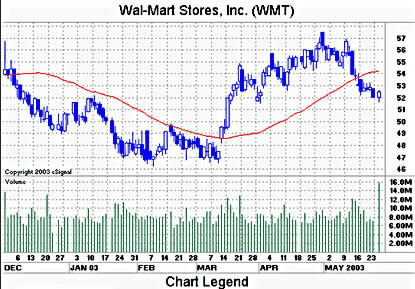
| Ticker Tape Digest -Home | Subscribe To TTD | Sample TTD Pro Report | Sample TTD Report Limited | Sample a TTD Stock Market Video Show | Translate to any Language |

By Leo Fasciocco, Ticker Tape Digest, Syndicated Investment Columnist
Twenty-five or so years ago, no one had a computer to help with investments. Today, everyone is staring at a computer screen and either trading or analyzing stocks.
Yet, many investors make the same mistake as those trading 25 years ago.
Emotions get one excited.

So, traders still cut and run with a small profit or hang on and watch a stock sink into an abyss. Other traders have their favorite indicator to guide their investment strategy and, lo and behold, it goes haywire and losses pile up. What is needed is discipline and a well-thought-out and back-tested method of investing.
Trader Thomas Basso, who runs his own investment firm in Scottsdale, AZ, once said to me: "During the trading day, we think of ourselves as the dumb monkeys that just push the buttons."
Basso, who was highlighted in the excellent book The New Market Wizards by Jack D. Schwager, was described as Mr. Serenity.
When Basso used the term "dumb monkeys” he was referring to the fact that he and his staff trade during the markets without wavering from using their systems. During off-market hours, they spend their time computer-testing trading systems.

Investors have the same opportunities to back test various trading strategies.
Investors can go to the Help section in the eSignal.com web site and find information on back testing when you choose the selection “EFS Help Center and Library.” Clicking on the selection takes you to a page on the eSignal website where you’ll find all the information you need to know how to develop, back test and refine your trading strategies.
There is an old saying that a wise man learns from the experience of others.
Two good books that can help one get on track to trading with the help of computer back testing are Trading for a Living by Dr. Alexander Elder and Trading as a Business by Charlie F. Wright.
There are many trading systems that can be developed with a variety of ramifications. Of course the bottom line is, “Can they make money consistently without suffering a massive drawdown?”
That's where back testing and knowing the probabilities comes in mighty handy.
Some key points in developing a system include: 1 - The setup 2 - The trigger buy point 3 - A stop strategy 4 - An exit point.
The setup is the required pattern needed for a trade to be considered. The trigger buy point is the specific signal that says “Go.” A stop strategy is a method for exiting a position if it does not work. An exit point is a spot at which one will take all or begin to take some profits.
Many trading strategies are used with one or more indicators and sometimes with various screens for stock selection. A good way to study an indicator is to check when the stock topped or made a bottom and then market it on the indicator. Study the indicator to learn its pattern near tops and bottoms for the stock.
Screens are often used to trim the universe of stocks to be considered. This can take into account earnings growth, liquidity or industry strength. A screen is used to filter out the "undesirables."
One well-known trend-type trading system is to buy a stock breaking out from a seven-week or more base. The screen would cover only the firms showing strong earnings growth. This system with other filters was popularized by William O'Neil. He gave it the name CANSLIM for the various screens used. (See his book How To Make Money With Stocks.)
This system works very well on the long side in bull markets or during major rallies. It often has problems in choppy markets. Some good winners this year with this system are Garmin Ltd. (GRMN), which broke out from a base at $31 on February 18 and ran to $45.90 by mid-May, and Apollo Group Inc. (APOL), which ran up from a breakout at $47 on March 13 to $56 by mid-May.
There are systems that can be developed to handle choppy markets. They often use what is called an overbought or oversold indicator. In other words, when a stock sells off and then just begins to turn up, an indicator, such as a stochastic oscillator or Commodity Channel Index, will give a buy signal. The Stochastic or CCI will give a sell signal when the stock is extended according to the indicator's measure and showing a loss of upside price momentum.
Walmart (WMT), for example, gave a buy signal with the CCI indicator when the stock was $47.50 back on March 5. It gave a sell signal on March 24 at $52.50. Of course, there are ways to blend a trend-following strategy with an overbought-oversold one. It can be done by using different time frames, such as daily, weekly or monthly.
Also, a trading method must have some sort of money management strategy to go with it.
The power of the computer is a tremendous tool for investors to study and learn from "virtual experiences." The soldiers who fought in "Iraqi Freedom" used various combat simulators. They cited this as part of their success. Even baseball scouts and coaches use back statistics to study the success of various hitters against certain pitchers. (See espn.com.) So, for investors, training plus discipline can equal success.
Mr. Fasciocco's articles appear on www.tickertapedigest.com. He is an independent contributing writer for several national publications. He is also president of Corona Investment Management. To get a free trial subscription to the Ticker Tape Digest Pro Report, which comes out daily on the web with midday updates, send an email message to freetrial@tickertapedigest.com. Mr. Fasciocco can be reached by email at leo@tickertapedigest.com.
|
Marketwatch--- One of the best web sites for up to the minute information. |
|
Bloomberg--- Some good stories and covers a lot of ground especially overseas |
|
Microsoft Investor--- Slick with some good stores. Worth the trip. |
|
Securities & Exchange Commission--- Very good for documented background on companies. |
|
Business Wire--- Good for company searching. |
|
Investor's Edge--- Some research help. |
|
New York Times--- Some Tech coverage that can be helpful |
|
USA Today--- Plenty of news |
|
Business Week --- Mostly general business news. Some stocks. |
|
CNNMoney ---Good rapid coverage of days events and some interesting stories. |
|
Technical Analysis of Stock & Commodities---Very good articles on trading strategies. Very heavy with the math, but good investment studies for advanced traders and investors. |
|
Investor's Business Daily---A good site from an excellent investment newspaper. |
|
Markets.com -a good listing of stock-related web sites. |
Copyrighted - Ticker Tape Digest -- Some of the charts used are from esignal at esignal.com